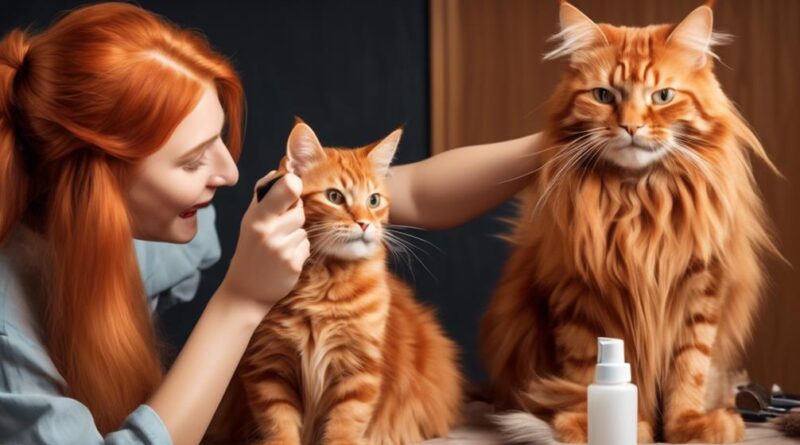What Are Effective Cat Grooming Techniques for Reducing Hairballs?
Tired of finding hairballs all over your house and having to clean up after your cat constantly? It's time to take control of the situation.
There are effective grooming techniques that can help reduce the frequency of hairballs, and you'll be surprised at how simple and manageable they are. By implementing a few key strategies, you can significantly improve your cat's grooming routine and minimize the occurrence of hairballs.
So, if you're ready to put an end to the hairball struggle, keep on reading to discover the best grooming practices for your feline friend.
Brushing Techniques
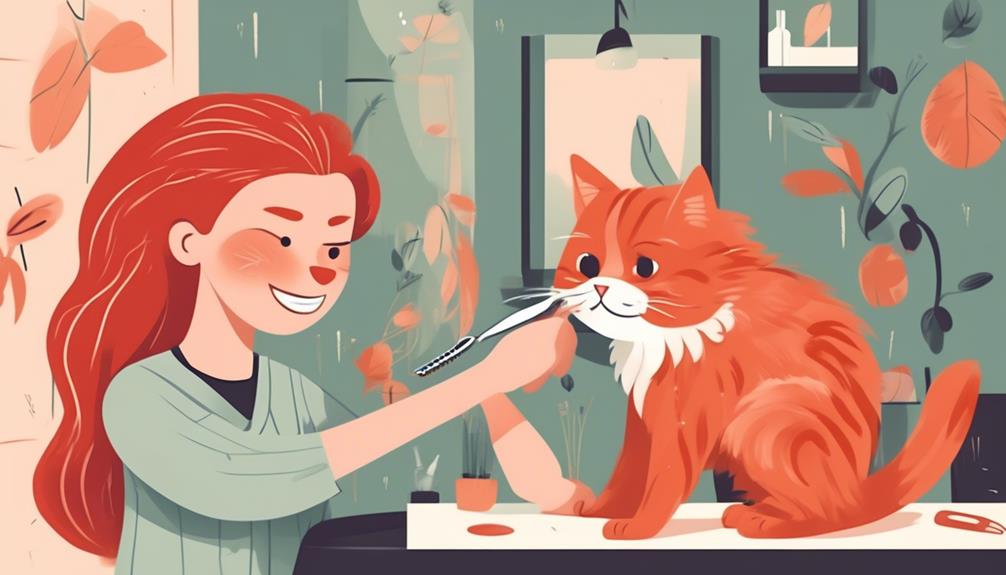
To effectively reduce hairballs, regularly brush your cat's fur using gentle, long strokes to remove loose hair and prevent excessive shedding. Shedding control is vital in minimizing hairballs, and regular brushing is the key. Make sure to use a brush specifically designed for your cat's hair type to maximize shedding control. Short-haired cats typically benefit from a fine-toothed comb or a slicker brush, while long-haired cats may require a wide-toothed comb or a specialized de-shedding tool. By using the right brush, you can effectively manage shedding and reduce the amount of loose hair your cat ingests during grooming.
In addition to shedding control, regular brushing also helps prevent mats from forming in your cat's fur. Mat prevention is essential for reducing hairballs, as mats can trap loose hair and exacerbate shedding. When brushing your cat, pay special attention to areas prone to matting, such as behind the ears, under the legs, and around the tail. Gently detangle any knots or mats using a comb or brush specifically designed for mat removal.
Diet and Nutrition
Considering your cat's diet and nutrition is crucial for managing hairballs. Nutritional supplements and dietary fiber play essential roles in preventing hairball formation. Including these elements in your cat's diet can help reduce the frequency of hairballs and improve their overall well-being.
Firstly, consider adding nutritional supplements to your cat's diet. Omega-3 fatty acids, found in fish oil or flaxseed oil, can help maintain healthy skin and coat, reducing excessive shedding and the ingestion of loose hair. Additionally, adding a digestive aid supplement containing enzymes and probiotics can aid in breaking down hair and promoting healthy digestion, reducing the likelihood of hairballs forming in your cat's stomach.
Secondly, focus on incorporating dietary fiber into your cat's meals. Fiber helps to move hair through the digestive tract, preventing it from clumping together and forming hairballs. Look for cat food that contains natural sources of fiber such as beet pulp, pumpkin, or cellulose. Alternatively, you can introduce small amounts of cooked vegetables, like green beans or carrots, to your cat's diet to increase their fiber intake.
Hairball Remedies
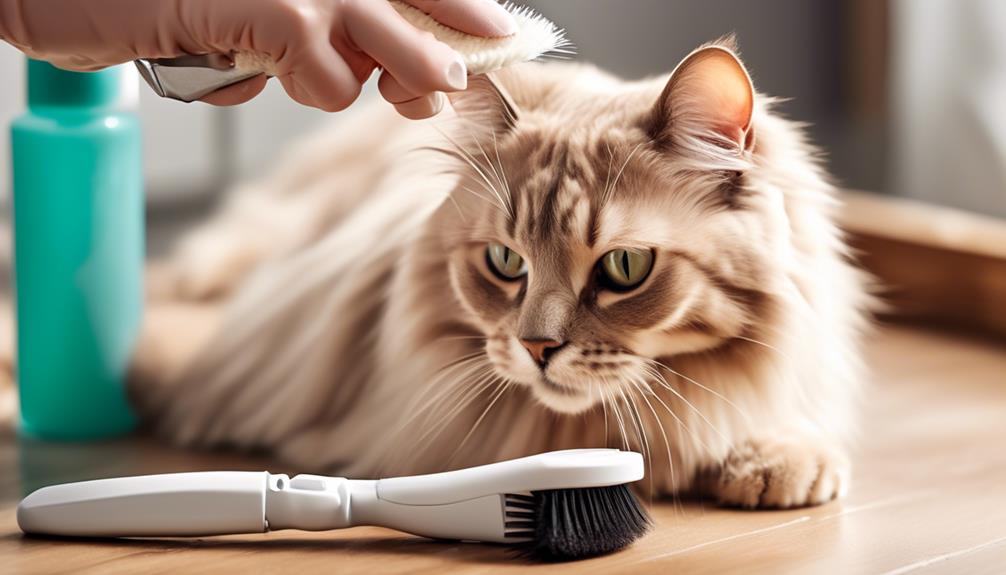
Managing your cat's hairballs can also involve exploring various remedies to alleviate the issue. Here are some effective remedies to help reduce hairballs in your cat:
- Natural remedies: Consider using natural remedies such as adding a small amount of pumpkin or olive oil to your cat's food. These can help lubricate the digestive system, making it easier for hair to pass through.
- Supplements: There are various supplements available that can aid in hairball prevention. Look for options that contain ingredients like omega-3 fatty acids, which can support a healthy coat and skin, reducing excessive shedding and hairball formation.
- Home remedies: You can also try home remedies such as regularly brushing your cat to remove loose fur and prevent excessive hair ingestion. This simple practice can significantly reduce the amount of hair your cat ingests, leading to fewer hairballs.
- Homemade treats: Consider making homemade treats that contain natural fibers like psyllium, which can aid in digestion and help move hair through the digestive tract. These treats can serve as a tasty way to promote hairball prevention.
- Hydration: Ensuring your cat stays well-hydrated is essential for preventing hairballs. Consider adding wet food to their diet or providing a running water source to encourage drinking.
Bathing Tips
When bathing your cat, it's important to approach the process calmly and patiently to help reduce their stress and make it a more positive experience for both of you. Firstly, ensure that the water temperature is lukewarm, as cats are sensitive to extreme temperatures. Use a spray nozzle or a pitcher to pour water gently over your cat, avoiding the ears and eyes.
Frequency of baths should be kept to a minimum, as bathing too often can strip the natural oils from your cat's skin and coat, leading to dryness and potential irritation. Unless your cat has gotten into something particularly messy, a bath every 4-6 weeks should suffice.
When it comes to shampoo selection, opt for a mild, cat-specific shampoo that's free from harsh chemicals and fragrances. Be sure to lather the shampoo gently and thoroughly, but avoid vigorous scrubbing as this can cause distress to your cat. After rinsing, use a soft towel to gently pat your cat dry, taking care to avoid vigorous rubbing.
Additionally, if your cat tolerates it, a low-heat setting on a pet-specific hairdryer can be used to help dry their coat, but be sure to introduce the sound and sensation to your cat gradually to prevent further stress.
Regular Vet Check-ups
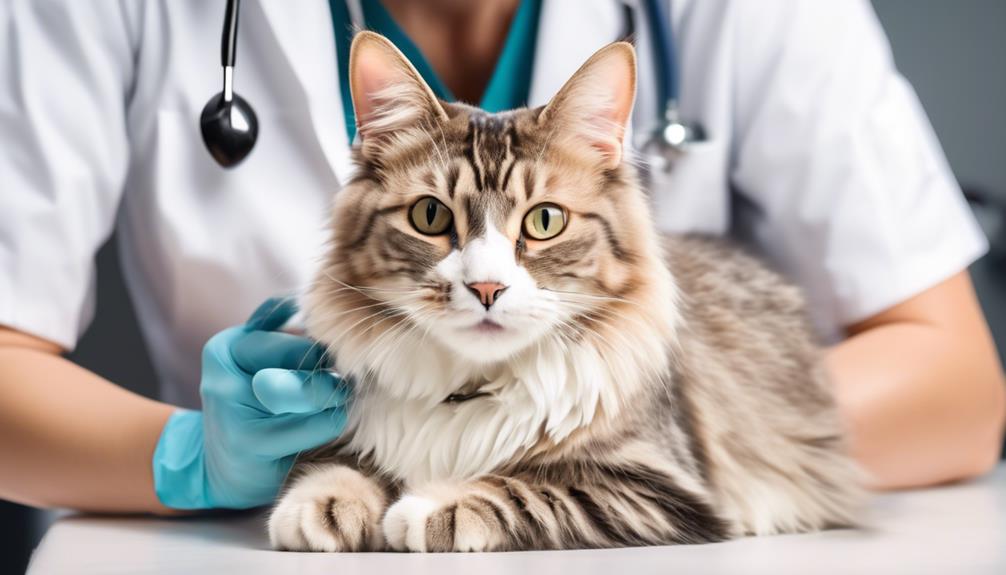
To ensure your cat's overall well-being and health, regular vet check-ups are essential, especially given the importance of maintaining a positive grooming experience during baths. Regular visits to the vet play a crucial role in keeping your cat healthy and happy.
Here are some key aspects to focus on during these check-ups:
- Dental Care: Your vet can provide professional dental cleanings and offer advice on at-home dental care to prevent dental issues such as periodontal disease.
- Vaccination Schedule: Your vet will ensure that your cat is up to date on all necessary vaccinations to protect against common feline diseases.
- Parasite Prevention: Regular check-ups allow the vet to monitor your cat for any signs of parasites and to provide appropriate preventive treatments.
- Weight Management: The vet can assess your cat's weight and body condition, providing guidance on nutrition and exercise to maintain a healthy weight.
- Overall Health Assessment: A vet check-up includes a thorough examination to detect any underlying health issues early on.
Grooming Tools
For effective grooming techniques to reduce hairballs, selecting the right grooming tools is crucial for maintaining your cat's coat. Shedding control and coat maintenance are essential aspects of grooming that can be effectively managed with the appropriate tools.
One of the most basic yet effective grooming tools is a fine-toothed comb. This tool is ideal for removing loose fur and preventing it from being swallowed during grooming, ultimately reducing the formation of hairballs.
Additionally, a bristle brush can help distribute natural oils throughout your cat's coat, promoting a healthier skin and reducing excessive shedding.
Another useful grooming tool for shedding control is the de-shedding tool. This tool is specifically designed to remove loose fur from the undercoat, which is often the primary source of hairballs. By using a de-shedding tool regularly, you can significantly minimize the amount of loose fur ingested by your cat during grooming.
Moreover, investing in a grooming glove can be beneficial for both shedding control and coat maintenance. The textured surface of the glove allows you to gently massage your cat while effectively capturing loose fur. This not only reduces shedding around the home but also enhances the overall health and appearance of your cat's coat.
Environmental Enrichment
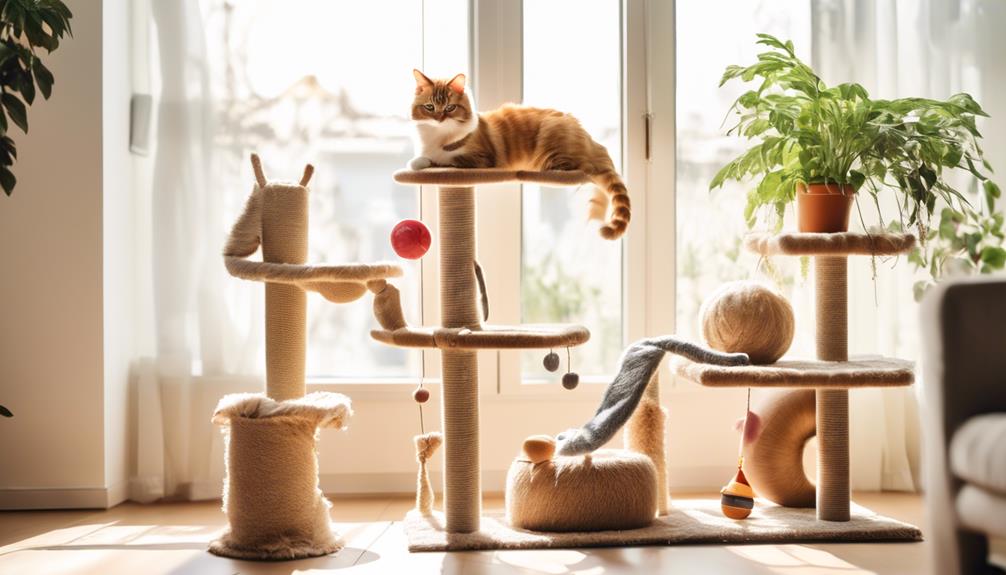
Consider enriching your cat's environment with interactive toys and engaging activities to promote physical and mental stimulation. Providing your feline friend with a stimulating environment can help reduce stress, prevent boredom, and decrease the likelihood of excessive grooming and subsequent hairball formation.
- Interactive Toys: Invest in a variety of interactive toys such as puzzle feeders, feather wands, and treat balls to keep your cat mentally engaged and physically active. These toys encourage natural hunting and pouncing behaviors, providing mental stimulation and exercise.
- Climbing Structures: Cats love to climb and perch in high places. Consider incorporating cat trees, shelves, or window perches to create vertical spaces for your cat to explore. Climbing structures not only provide physical exercise but also offer a sense of security and territory for your cat.
- Hiding Spots: Cats often seek out cozy hiding spots to observe their surroundings or take a peaceful nap. Providing hiding spots such as cozy beds, enclosed cat condos, or even cardboard boxes can offer your cat a sense of security and privacy, reducing stress and promoting mental well-being.
- Rotating Toys: Introduce a rotation system for your cat's toys to prevent boredom. By periodically swapping out toys, you can keep your cat's environment fresh and exciting, stimulating their curiosity and preventing them from getting tired of the same toys.
- Sensory Stimulation: Incorporate sensory stimulation into your cat's environment through the use of toys with different textures, scents, and sounds. This variety can keep your cat mentally engaged and provide enrichment.
Hairball Prevention Practices
Regular grooming of your cat is essential for preventing hairballs and maintaining their coat's health. Hairball control is crucial in reducing the risk of hairball formation. To effectively manage hairballs, brush your cat regularly to remove loose fur. This not only minimizes the amount of hair your cat ingests but also reduces shedding around your home. Use a specialized cat brush designed to capture loose fur and prevent it from being licked and swallowed.
Additionally, providing your cat with a balanced diet that includes specially formulated hairball control cat food can help minimize hairball formation. These diets often contain natural fiber that aids in the passage of hair through the digestive system, reducing the likelihood of hairballs forming.
Shedding management is also vital in hairball prevention. Besides regular brushing, consider using grooming wipes to remove loose fur and dander from your cat's coat. This can be particularly helpful for cats that aren't fond of traditional brushing.
Furthermore, ensuring that your cat stays hydrated can aid in managing hairballs. Encourage water intake by providing clean, fresh water sources throughout your home and consider incorporating wet food into your cat's diet.
Frequently Asked Questions
Can Hairballs Be a Sign of a More Serious Health Issue in Cats?
Hairballs can be a sign of a more serious health issue in cats. Look out for changes in appetite, lethargy, and vomiting. Common grooming mistakes, like not brushing regularly, can contribute to hairball formation.
Are There Any Specific Grooming Techniques That Can Help Reduce Shedding and Prevent Hairballs in Long-Haired Cats?
To reduce shedding and prevent hairballs in long-haired cats, try incorporating regular brushing techniques into your grooming routine. This helps control shedding and minimizes the amount of loose hair your cat ingests, reducing hairball formation.
How Often Should I Groom My Cat to Prevent Hairballs?
To prevent hairballs, groom your cat regularly. Long-haired cats may need daily brushing, while short-haired cats benefit from a few times a week. Grooming helps control shedding and prevents hairballs. Establish a grooming schedule for best results.
Are There Any Specific Dietary Supplements or Treats That Can Help Prevent Hairballs in Cats?
You can help prevent hairballs in cats by incorporating dietary supplements and treats into their diet. Look for products containing fiber or oils to aid in digestion and reduce hairball formation.
Can Excessive Grooming or Hairball Vomiting Be a Sign of Stress or Anxiety in Cats?
Excessive grooming or hairball vomiting may signal stress or anxiety in cats. To address this, focus on stress management and grooming techniques. Observe behavioral changes and grooming habits, and consult a vet for advice on managing your cat's stress.
Conclusion
So, by using effective cat grooming techniques such as regular brushing, providing a balanced diet, and using hairball remedies, you can help reduce hairballs in your furry friend.
Remember to schedule regular vet check-ups, and use grooming tools to keep your cat's coat healthy.
Environmental enrichment and hairball prevention practices will also contribute to keeping your cat happy and hairball-free.
With these simple techniques, you can help your cat live a more comfortable and hairball-free life.
